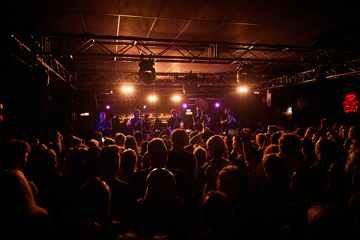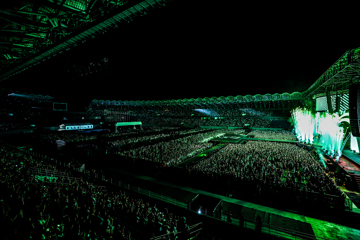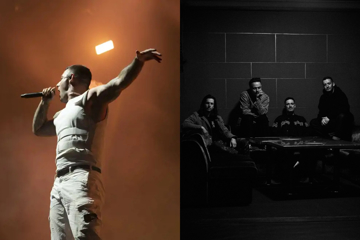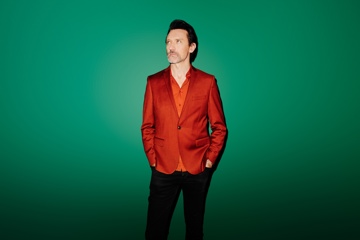Local Underground Electro Legend Ash Wednesday Is Back: 'It's Quite A Buzz'
Bryget Chrisfield checks in with Ash Wednesday ahead of the world premiere of his latest project 'The AfterMATH' - a body of work commissioned for Melbourne Town Hall's grand organ - to geek out about synths and discuss how this instrument has shaped his life from JAB to Models and beyond.
Our chat with Ash Wednesday takes place following a rehearsal for the world premiere performance of The AfterMATH and the Australian electronic music pioneer shares, "I've been working on the pieces on my computer, with little virtual organ sounds going through mini speakers. It's quite a buzz to go from that environment to Melbourne Town Hall where you have the beautiful acoustic vibrations all around you... I've never contemplated working with a grand organ before and it's quite exciting."
The AfterMATH is a body of work commissioned for Melbourne Town Hall's 10,000-pipe grand organ and Wednesday explains, "It's based on a chord progression, which has been circulating around in my head for quite a long time now." A couple of pieces soon became enough material for "a nightly presentation" and Wednesday says "there's one piece which is static": "The way that I composed that was using I suppose what you would call the surrealist system of automatic writing, which was based on writing text quickly, and without thinking, and mindlessly, and in a hurried sort of way. I put together a piece of music on my laptop at four in the morning when I woke from a dream, and before I had time to think I was sketching - almost like charcoal drawings - onto a music program, which I then - in the morning - transferred onto another computer and hurriedly sort of copied and pasted that, and altered that paste, and then copied that one and altered that and altered that etcetera until I put together a piece of music, which I was doing from total visuals. I wasn't listening to it, I was just looking at the patterns and not really paying too much attention to what the notes were and sort of mandatorily throwing a couple of notes out here and there, and shifting them around and stretching them - making them longer in duration. So just mindlessly changing, altering the piece so it was gradually becoming sparser and thinned out until it eventually ended up as three notes, which I suppose you would call a resolution. So that was kind of exciting and when I played it I thought, 'Oh, yeah! Yeah, that sounds ok!' If it hadn't sounded ok, I would've done it all over again."
Wednesday was integral to the development of Australian synth-pop and minimal music throughout the '70s and '80s, and is clearly obsessed with synths. When asked whether he remembers the first time he ever heard a synth, Wednesday recalls a friend of his playing a 1968 record called Switched-On Bach during their music club. "That was a very exciting sound and I thought, 'Yeah, that's really great!'... Back in the day something like that would be about two or three rooms full of patched technical..." A bit like a server room? "Yeah, like a telecom connection gone wild. It would've cost countless thousands and I thought, 'Gee, I'll get a job and by the time I'm 60 I'll be able to buy one'."
But then the Minimoog was manufactured. "You could buy one of them for about half the price of a family car back in the day, so it was affordable," Wednesday reveals. "My friend Johnny [Crash] - who played in JAB, actually - had a thing called an ARP synthesiser, which was a flat-faced synthesiser with lots of coloured sliders on it, and he used to sorta turn it up really loud and make all these really crazy sounds and laugh his head off! He just thought it was so funny and I thought, 'Yeah, that's great! I really like that. I'll get one of those too!' So in JAB we had two synthesisers - two identical synthesisers - and Bohdan [X] playing an acoustic guitar, and Johnny could also play fantastic drums when he chose to. But that was the line-up of our group, originally."
"It's the sort of thing which a human being wouldn't be capable of performing."
As well as JAB, Wednesday was a founding member of the first line-up of Models, later going on to play in The Metronomes, Modern Jazz and Crashland! before relocating to Berlin where he worked with Nina Hagen and became a live performance member of Einstürzende Neubauten. Of his days in Models, Wednesday shares, "I remember composing some of my synthesiser solos by drawing the notes out of a hat... On an album called Melbourne there's a track called Body Shop and the solo on that was one was composed in that way... I've always enjoyed the possibility of chance and I've always tried to incorporate that into my music."
Don't miss a beat with our FREE daily newsletter
Although Wednesday finds it "very difficult to do any sort of performance" these days, after he was "stricken with an ailment which means [he's] losing contact with the right side of [his] body", The AfterMATH will see him controlling Melbourne Town Hall's grand organ via MIDI (Musical Instrument Digital Interface). "I can control the organ from my computer and at the same time I'm using a synthesiser or two here and there, and operating the stops," Wednesday elaborates. "The musical pieces are constructed in such a way that I can interact [with them].
"The third piece is set up so that, really, it can just play forever, and it will never repeat itself, and at the same time I can get in and I can interact with various integers or I can just let it play by itself, too. And that sort of thing is quite exciting, I think, and it's the sort of thing which a human being wouldn't be capable of performing, because again it's spontaneous composition or performance; it's setting up an environment for that to occur - that's the compositional element of it."







